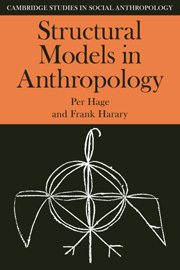8 - Graphs and groups
Published online by Cambridge University Press: 05 March 2010
Summary
Over and beyond the schemes of atomist association on the one hand and emergent totalities on the other, there is, however, a third, that of operational structuralism. It adopts from the start a relational perspective, according to which it is neither the elements nor a whole that comes about in a manner one knows not how, but the relations among elements that count.
Jean Piaget, StructuralismIn structural analysis, algebraic metaphors are commonly used to convey the idea of sets of concepts or practices related by transformation rather than by simple difference or similarity. Words like “group,” “permutation,” “inverse,” and “boolean” occur, and there may even be mathematical symbols like x, −x, 1/x, − 1/x. In anthropology, as contrasted, say, to genetic epistemology, group models are evoked rather than defined. But they nonetheless play an important role in the analysis of symbolism, as may be illustrated by two examples from Mythologiques.
In The origin of table manners, Lévi-Strauss analyzes beliefs about the outcomes of complementary male activities among a number of North American Indian tribes by using the analogy of the Klein group:
The possession of a scalp ensures success in war, while the ingestion of female scurf leads to lack of success in hunting. According to M493b, the non-ingestion of the liver is the pre-condition of the husband's success in hunting (Hoffman, pp. 182–5; Skinner-Satterlee, pp. 399–400). Lastly, menstrual blood causes lack of success in fighting; the Plains Indians would remove the sacred bundles used for military rites from a tent when there was a menstruant woman. […]
- Type
- Chapter
- Information
- Structural Models in Anthropology , pp. 151 - 170Publisher: Cambridge University PressPrint publication year: 1984

